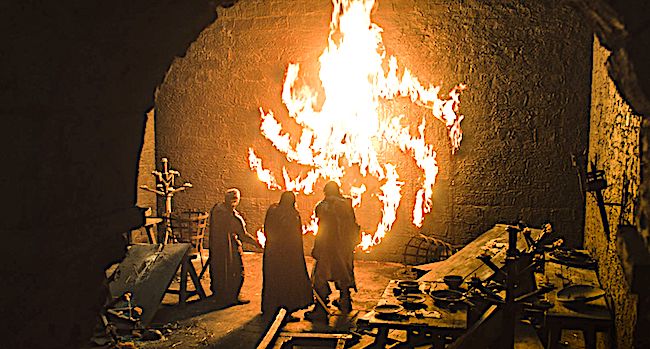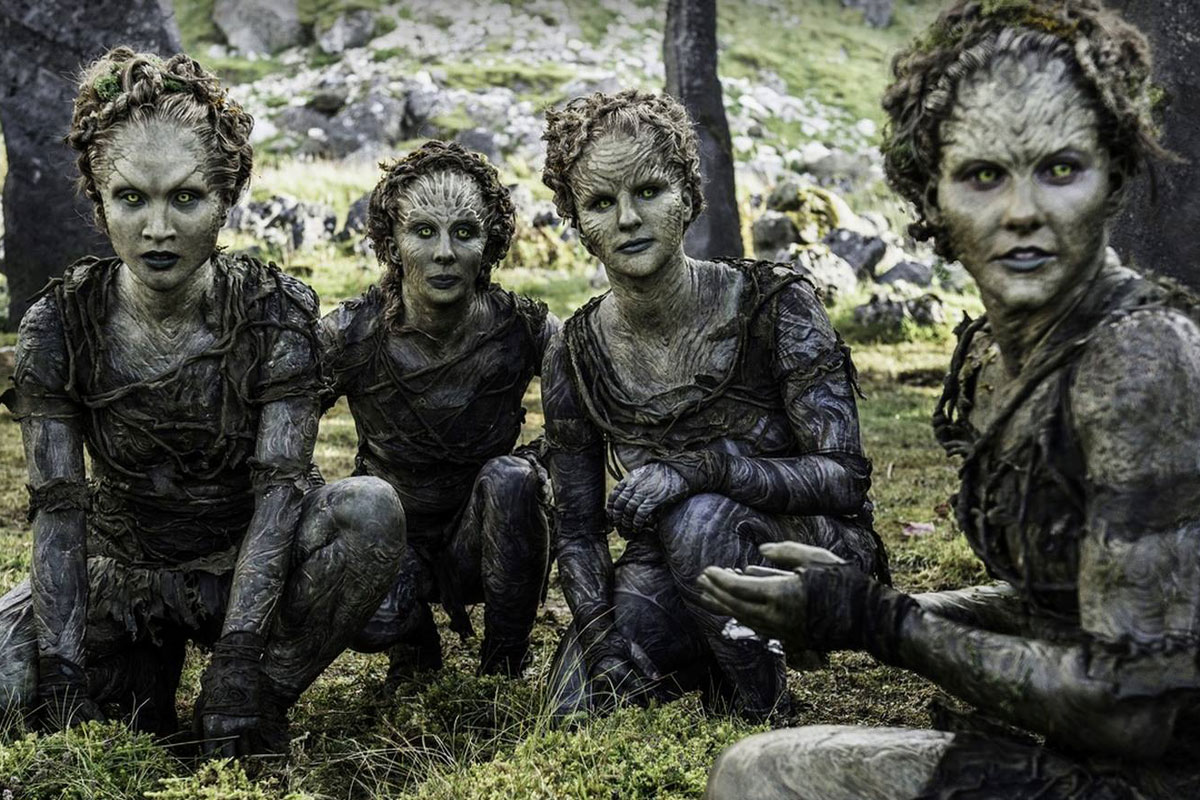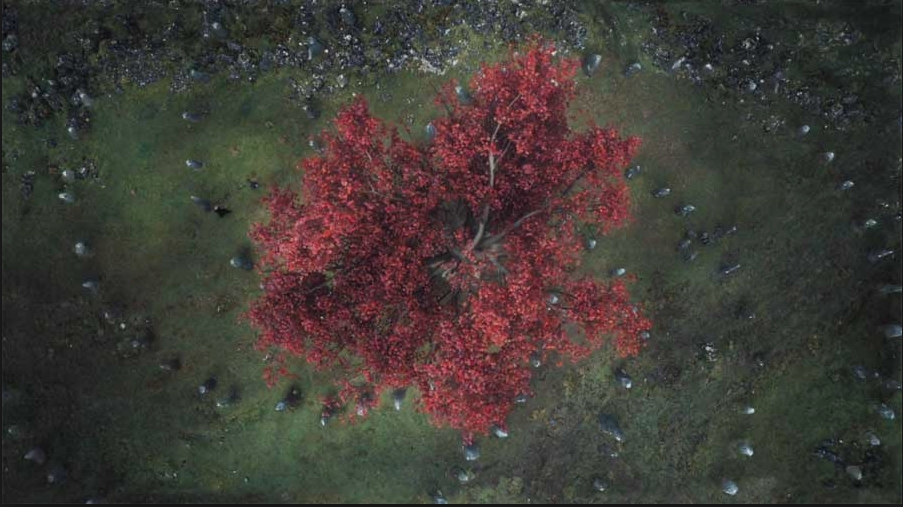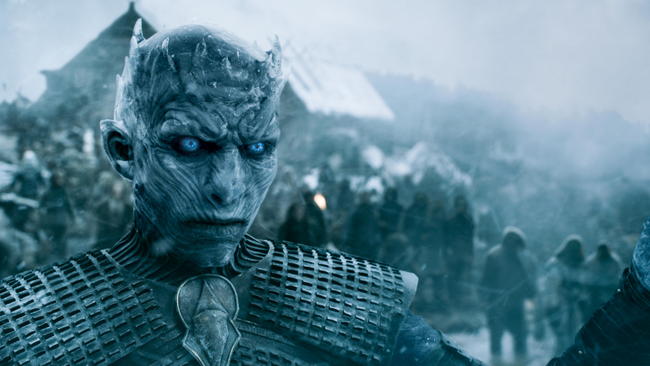
Game of Thrones ended the first episode of its final season in a way fans have come to expect: with fire and blood.
The season eight premiere was filled with happy reunions, tense stand-offs, dragon fly-bys, and a surprising amount of humor before creators D.B. Weiss and David Benioff brought us something more familiar, and it came in the shape of a symbol that’s been haunting the show since season one.
Before the Night King and his army of undead foot soldiers finished raiding, pillaging, and murdering every member of House Umber at Last Hearth they left a particularly gruesome calling card for Tormund, Beric, and their merry band of Night’s Watch survivors to find. The young and very dead Lord Ned Umber was pinned to a castle wall with body parts strewn about in a distinct spiral pattern. When lifeless Ned is reanimated (because, magic) Beric lights him on fire, igniting the symbol too.
The visual is a striking one and though it could just be a method of instilling fear into the hearts of men (and, let’s be honest, fans as well) with only a handful of episodes left, it seems unlikely Weiss and Benioff would waste precious screen-time on anything inconsequential to the major storyline.
So, as is our way, let’s breakdown the symbol of the Night King, what it means, and what clues it offers to the villain’s ultimate endgame.
The Children of The Forest

We haven’t heard much about the Children of the Forest since Leaf and her cohorts died protecting Bran and Meera from the Night’s King’s army. Still, it’s important to remember that the same symbol the Night King keeps carving via dismembered body parts first belonged to the Children of the Forest, the ones responsible for the creation of the First White Walker.
Leaf explains to Bran back in season six why the Children used dragon-glass to kill men they had captured and brought them back to life through their ancient magic. They hoped to use the White Walkers against the First Men, pitting the living against the dead in order to protect their holy weirwood trees. The war between the Children and the First Men lasted thousands of years before the creation of White Walkers and it was only when they turned on their masters, when the Night King began murdering Children of the Forest and the First Men indiscriminately, that the two sides allied in their greater war against death itself.
Variations of the symbol have been around since the first episode of the series, but in a flashback to the creation of the Night King, we see how it’s connected to the White Walkers. The Godswood tree on which the first man was sacrificed stands at the center of the mystical pattern as the Children of the forest position themselves around it. This is how the first White Walkers were forged, and it seems, the Night King hasn’t forgotten.
The Symbol’s Meaning

Because this symbol appears numerous times in the series across Westeros – Dragonstone, North of the Wall, Last Hearth – it’s worth examining it closer. The Children of the Forest were natives of Westeros, living there long before the First Men arrived. They were magically gifted creatures who used nature in their rituals, incorporating the forests they called home in their harnessing of power.
Weirwood trees were sacred to the Children of the Forest. They carved faces in them, worshipped them, possibly drew their magic from them. The symbol could reference this fact, with the weirwood being at the center and the Children of the Forest surrounding it, symbolizing how magic and nature are connected. The fact that the Night King also uses this symbol could be proof of Jon Snow’s theory, that if the Night King falls, all those that draw power from him will also die.
Other theories liken the symbol to a specific weather pattern, believing the Night King uses it to spread winter further South, though it seems winter’s already come to much of Westeros without dead body parts heralding its arrival, so that may be unlikely.
Another theory that gained some traction after season eight’s premiere is that the symbol is connected to the Targaryen sigil, hinting that the Night King may share ancestry with Daenerys and Jon. There are some strange coincidences to back up this belief – the fact that Targaryens were the first to decorate their weapons with Dragonglass, that the Children of the Forest may have been on Dragonstone at one point, that Valyrian steel is the only other weapon that can destroy White Walkers and Valryia is where Targaryens hail from. The two patterns are eerily similar, but Targaryens didn’t invade Westeros until thousands of years after the creation of the Night King, so it seems like a stretch to connect the two.
The Night King’s Endgame

Whether we discover the meaning of the pattern or not, the fact that the Night King keeps carving it with his victims’ leftovers might be proof of a particularly fleshed-out theory from Reddit user MrSilenceT that uses a bit of geography to surmise the White Walkers’ endgame.
Harrenhal is a place we’ve seen plenty of before but it’s what surrounds the castle that might be even more important. It sits on the coast of Gods Eye, a large lake on the southern edge of the Riverlands. The Gods Eye holds the Isle of Faces, an island at its center that’s notoriously difficult to find because it’s believed to be inhabited by the Green Men, priests of the Old Gods with supernatural abilities and thus, cloaked in magic.
Whether the Green Men exist or not, what definitely does reside on the Isle of Faces are the main Heart Trees, the most ancient and magical of weirwood trees with faces carved by the Children of the Forest thousands of years earlier. The theory is that the Night King wants to make it to the Isle of Faces to either destroy the trees and break the curse that keeps him undead, or perhaps harness their power, maybe to come back to life fully human or to just wipe out all of Westeros? Who really knows, but it does seem like this connection to the Children, this symbol, hints at a goal bigger than just “kill the living.”
After all, George R.R. Martin is someone who enjoys forcing us to both hate and empathize with his characters, so having the Night King be completely evil just doesn’t gel with the overall vibe of this show.






